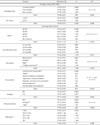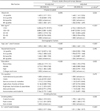Abstract
Purpose
The aim of this study was to determine the relationship between serum concentrations of 25-hydroxyvitamin D [25(OH)D] and chronic obstructive pulmonary disease (COPD) prevalence.
Methods
The analysis was performed using data from the Fifth Korean National Health and Nutrition Examination Survey, a cross-sectional survey of the Korean civilian population conducted from 2010 to 2012. The analyses were restricted to males who were 40 years of age and above. Complex sample multiple logistic regression analyses were used to examine the associations of COPD prevalence with 25(OH)D and other factors.
Results
FEV1/FEV6 varied significantly with smoking status, age, household income, education level, occupation, body mass index (BMI), and physical activity (p < 0.05). In univariate analysis, smoking status, BMI, household income, education level, and occupation showed association with COPD (p < 0.05), but vitamin D was not associated with COPD (p = 0.078). However, when adjusted with smoking status, household income, education level, occupation, BMI, age, and smoking index, the lowest quartile of 25(OH)D showed OR 1.643 (95% CI 1.161-2.236) compared to 3rd quartile (p = 0.024).
Figures and Tables
Table 1
Serum 25-hydroxyvitamin D levels of males according to smoking status and the other factors in KNHANES V1)

Abbreviations: SE, standard error. N, unweighted frequency. FEV1, forced expiratory volume for 1 second. FEV6, forced expiratory volume for 6 seconds. BMI, body mass index
1) Data are expressed as estimates ± SE in ng/ml of 25-hydroxyvitamin D. 2) Calculated by complex sample general linear model (CSGLM)
References
1. Wacker M, Holick MF. Vitamin D: Effects on skeletal and extraskeletal health and the need for supplementation. Nutrients. 2013; 5(1):111–148.
2. Muscogiuri G, Sorice GP, Ajjan R, Mezza T, Pilz S, Prioletta A, Scragg R, Volpe SL, Witham MD, Giaccari A. Can vitamin D deficiency cause diabetes and cardiovascular diseases? Present evidence and future perspectives. Nutr Metab Cardiovasc Dis. 2012; 22(2):81–87.

4. Evatt ML, Delong MR, Khazai N, Rosen A, Triche S, Tangpricha V. Prevalence of vitamin d insufficiency in patients with Parkinson disease and Alzheimer disease. Arch Neurol. 2008; 65(10):1348–1352.

5. Black PN, Scragg R. Relationship between serum 25-hydroxyvitamin D and pulmonary function in the third national health and nutrition survey. Chest. 2005; 128:3792–3798.
6. World Health Organization [Internet]. The top 10 causes of death. Geneva: Cited 2014 May. Available from: http://www.who.int/mediacentre/factsheets/fs310/en/.
7. Sundar IK, Hwang JW, Wu S, Sun J, Rahman I. Deletion of vitamin D receptor leads to premature emphysema/COPD by increased matrix metalloproteinases and lymphoid aggregates formation. Biochem Biophys Res Commun. 2011; 406(1):127–133.

8. Kunisaki KM, Niewoehner DE, Singh RJ, Connett JE. Vitamin D status and longitudinal lung function decline in the Lung Health Study. Eur Respir J. 2011; 37(2):238–243.

9. Crane-Godreau MA, Black CC, Giustini AJ, Dechen T, Ryu J, Jukosky JA, Lee HK, Bessette K, Ratcliffe NR, Hoopes PJ, Fiering S, Kelly JA, Leiter JC. Modeling the influence of vitamin D deficiency on cigarette smoke-induced emphysema. Front Physiol. 2013; 4:132.

10. Finklea JD, Grossmann RE, Tangpricha V. Vitamin D and chronic lung disease: a review of molecular mechanisms and clinical studies. Adv Nutr. 2011; 2(3):244–253.

11. Monadi M, Heidari B, Asgharpour M, Firouzjahi A, Monadi M, Ghazi Mirsaied MA. Relationship between serum vitamin D and forced expiratory volume in patients with chronic obstructive pulmonary disease (COPD). Caspian J Intern Med. 2012; 3(3):451–455.
12. Shaheen SO, Jameson KA, Syddall HE, Aihie Sayer A, Dennison EM, Cooper C, Robinson SM. The relationship of dietary patterns with adult lung function and COPD. Eur Respir J. 2010; 36(2):277–284.

13. Shaheen SO, Jameson KA, Robinson SM, Boucher BJ, Syddall HE, Sayer AA, Cooper C, Holloway JW, Dennison EM. Relationship of vitamin D status to adult lung function and COPD. Thorax. 2011; 66(8):692–698.

14. Guessous I, Dudler V, Glatz N, Theler JM, Zoller O, Paccaud F, Burnier M, Bochud M. Vitamin D levels and associated factors: a population-based study in Switzerland. Swiss Med Wkly. 2012; 142:0.

15. Choi HS, Oh HJ, Choi H, Choi WH, Kim JG, Kim KM, Kim KJ, Rhee Y, Lim SK. Vitamin D insufficiency in Korea-a greater threat to younger generation: the Korea National Health and Nutrition Examination Survey (KNHANES) 2008. J Clin Endocrinol Metab. 2011; 96(3):643–651.

16. Jung IK. Prevalence of vitamin D deficiency in Korea: Results from KNHANES 2010 to 2011. J Nutr Health. 2013; 46(6):540–551.

17. Ministry of Health and Welfare, Korea Centers for Disease Control and Prevention. Korea Health Statistics 2010: Korea National Health and Nutrition Examination Survey (KNHANES V-1). Cheongwon: Korea Centers for Disease Control and Prevention;2011.
18. Ministry of Health and Welfare, Korea Centers for Disease Control and Prevention. Korea Health Statistics 2011: Korea National Health and Nutrition Examination Survey (KNHANES V-2). Cheongwon: Korea Centers for Disease Control and Prevention;2012.
19. Ministry of Health and Welfare, Korea Centers for Disease Control and Prevention. Korea Health Statistics 2012: Korea National Health and Nutrition Examination Survey (KNHANES V-3). Cheongwon: Korea Centers for Disease Control and Prevention;2013.
20. Kweon S, Kim Y, Jang MJ, Kim Y, Kim K, Choi S, Chun C, Khang YH, Oh K. Data resource profile: The Korea National Health and Nutrition Examination Survey (KNHANES). Int J Epidemiol. 2014; 43:69–77.

21. Weisman Y. Vitamin D deficiency and insufficiency. Isr Med Assoc J. 2013; (7):377–378.
22. Haddad JG, Rojanasathit S. Acute administration of 25 hydroxycholecalciferol in man. J Clin Endocrinol Metab. 1976; 42(2):284–290.
23. Stamp TC, Round JM, Rowe DJ, Haddad JG. Plasma levels and therapeutic effect of 25-hydroxycholecalciferol in epileptic patients taking anticonvulsant drugs. Br Med J. 1972; 4(5831):9–12.

24. Birge SJ, Haddad JG. 25-Hydroxycholecalciferol stimulation of muscle metabolism. J Clin Invest. 1975; 56:1100–1107.

25. The Korean Academy of Tuberculosis and Respiratory Disease. Guide to COPD diagnosis, 2012 revision. Seoul: 2012.
26. Persson LJ, Aanerud M, Hiemstra PS, Hardie JA, Bakke PS, Eagan TM. Chronic obstructive pulmonary disease is associated with low levels of vitamin D. PLoS One. 2012; 7(6):e38934.

27. Korn S, Hübner M, Jung M, Blettner M, Buhl R. Severe and uncontrolled adult asthma is associated with vitamin D insufficiency and deficiency. Respir Res. 2013; 14:25.

28. Kunisaki KM, Niewoehner DE, Connett JE. COPD Clinical Research Network. Vitamin D levels and risk of acute exacerbations of chronic obstructive pulmonary disease: a prospective cohort study. Am J Respir Crit Care Med. 2012; 185(3):286–290.
29. Christakos S, Ajibade DV, Dhawan P, Fechner AJ, Mady LJ. Vitamin D: metabolism. Endocrinol Metab Clin North Am. 2010; 39(2):243–253.

30. Christakos S, Hewison M, Gardner DG, Wagner CL, Sergeev IN, Rutten E, Pittas AG, Boland R, Ferrucci L, Bikle DD. Vitamin D: beyond bone. Ann N Y Acad Sci. 2013; 1287:45–58.

31. Christakos S, DeLuca HF. Minireview: Vitamin D: is there a role in extraskeletal health? Endocrinology. 2011; 52(8):2930–2936.

33. Hansdottir S, Monick MM, Hinde SL, Lovan N, Look DC, Hunninghake GW. Respiratory epithelial cells convert inactive vitamin D to its active form: potential effects on host defense. J Immunol. 2008; 181(10):7090–7099.

34. Hansdottir S, Monick MM. Vitamin D effects on lung immunity and respiratory diseases. Vitam Horm. 2011; 86:217–237.





 PDF
PDF ePub
ePub Citation
Citation Print
Print




 XML Download
XML Download